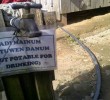NABUNTURAN, COMPOSTELA VALLEY—It’s now or never.
Two international plant scientists pressed for a massive information and education campaign to raise awareness about the rafflesia mira, a parasitic flowering plant related to the species of the world’s biggest flower and found only in the foothills of the mountain ranges of Maragusan in Compostela Valley.
Dr. Daniel Nickrent, professor from Southern Illinois, United States, believes the population in all 11 sites he has visited, together with Dr. Julie Barcelona, an international Filipino botanist from the Philippine National Museum, belonged to the same rafflesia mira species. He explained that the genus rafflesia (R.), with known 15 species, is found only in Thailand, Malaysia, Indonesia, and the Philippines. It is among the rarest to see and the most endangered flowers in South-East Asia. Ten of these species are found in the Philippines, including Maragusan’s R. mira discovered by Filipino scientists led by Dr. Edwino Fernando and Dr. Perry Ong in the foothill village of New Albay in Maragusan five years ago. 
Maragusan’s R. mira was the fourth rafflesia species identified in the Philippines, along with R. speciosa in Antique and R. manillana in Samar and Luzon.
Another group later published another name for Maragusan’s rafflesia, R. magnifica. However, rafflesia mira stands as the nomenclaturally valid name. An R. mira in bloom measures 45-60 cm in diameter, approximately the same size as R. speciosa’s 45-56 cm, but larger than Luzon’s R. manillana’s 14-20 cm diameter.
One other species, R. schadenbergiana was last recorded in 1882 in Mt. Apo in Davao and widely believed to have been extinct until buds of the species was rediscovered in South Cotabato in 1994. In 2007, Barcelona confirmed the discovery of yet another population of R. schadenbergiana in Bukidnon.
The other recorded rafflesia species in the Philippines are the R. lobata discovered in 2005 in the Mt. Igtuog and Mt. Sakpaw Central Panay mountain range; the R. baletei in the Mt. Isarog and Mt. Iriga range of Camarines Sur which was initially collected by botanist Danilo Balete in 1991; the R. banahawensis of Mt. Banahaw which Dr. Barcelona later renamed Rafflesia philippensis Blanco after her investigation found that the species was first named by a Spanish plant collector in 1845; the R. panchoana of Mt. Makiling, a new species discovered in 2007 after additional field and herbarium work by scientist D. A. Madulid and coauthors on the rafflesia known originally as R. manillana yielded the description of the new species; R. leonardi of sitio Kinapawan in the coastal town of Lal-lo in Cagayan Valley discovered in 2008; and R. aurantis discovered in 2009 in the Quirino Protected Landscape, Quirino Province, Luzon.
Rafflesia schadenbergiana, known as “bó-o” to the Bagobo tribe and “kolon busaw” to the Higaonon tribe of Bukidnon, has the largest flower among the Rafflesia species found in the Philippines with a diameter ranging from 52-80 centimeters. It has also the second largest flower in the genus after R. arnoldii of Indonesia which stretches up to one metre and can weigh up to nine kilograms.
Scientists say more than 1.3 acres of forest disappear from the Earth’s surface every second or 75 acres in one minute. This is also equivalent to 108,000 acres daily, and more than 40 million acres a year. Tropical rainforests are home to more than 50% of the world’s plant and animal species including the Rafflesia.
Nickrent explained that the rare rafflesia species, is a barometer of the health of the ecosystem. Once gone, he said, it would mean man’s source of food and other sustenance is either dead or dying.
Hope eternal
Christine Dompor, Compostela Valley tourism officer, has high hopes that the survival of Maragusan’s Rafflesia species might not be as bleak as its counterpart’s elsewhere. “We are heading towards that direction, to help protect and conserve this rare floral species,” Dompor said. “Conserving the Rafflesia is a component of our eco-tourism campaign which, itself, depends on a healthy natural environment,” she added.
Dompor said her office has had initial talks with authorities in Maragusan on conserving and protecting their Rafflesia population and has led a team in 2008 to explore the Rafflesia site in Brgy. Mapawa on the foothills of Mt. Kandalaga, less than 15 kilometers from the town center.
More explorations would be needed, she said, to officially identify other sites so that the tourism office and the municipal government of Maragusan could take action to protect and conserve the rare species.
Mayor Cesar Colina has fenced off the Mapawa Rafflesia site to prevent unwanted incursion into the sloping foothills. Dompor is optimistic about the mayor’s gesture. She also believes the country has enough laws to protect the Rafflesia.
Section 27 of Republic Act 9147 prohibits the collection, possession, transport and trading of all Rafflesia species listed as a critically endangered species under Department of Environment and Natural Resources (DENR) Administrative Order # 2007-01 on pain of 6-12 years imprisonment or a fine of 100, 000-1,000,000 pesos.
Still a lot has to be done, she said.
Until then, the tourism officer added, the office is on a “wait and see” position.
For reference:
Jimmy P. Abayon
PGP-Tourism Services Section
Province of Compostela Valley
Tel: (084) 3760 943
IMPORTANT NOTICE: INBOX is an archive of press releases, statements, announcements, letters to the editors, and manifestos sent to Davao Today for publication. Please email your materials to davaotoday@gmail.com. Davao Today is not responsible for the content of these materials. The opinion expessed in these items does not reflect those of Davao Today and its staff. Please refer to our terms of use/disclaimer.










